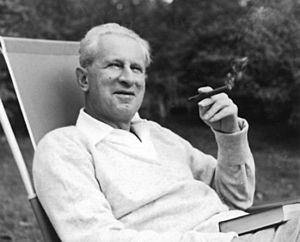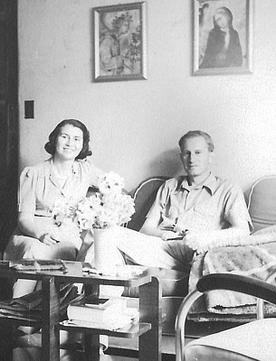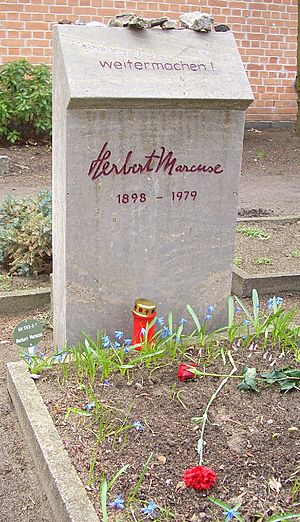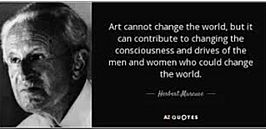Herbert Marcuse facts for kids
Quick facts for kids
Herbert Marcuse
|
|
|---|---|

Marcuse in 1955
|
|
| Born | July 19, 1898 |
| Died | July 29, 1979 (aged 81) Starnberg, West Germany
|
| Nationality |
|
| Alma mater | University of Berlin University of Freiburg |
|
Notable work
|
|
| Spouse(s) |
|
| Era | 20th-century philosophy |
| Region | Western philosophy |
| School |
|
| Doctoral students |
|
|
Main interests
|
|
|
Notable ideas
|
|
|
Influences
|
|
|
Influenced
|
|
Herbert Marcuse (born July 19, 1898 – died July 29, 1979) was a German-American philosopher, social critic, and political theorist. He was part of the Frankfurt School of critical theory, a group of thinkers who looked closely at society.
Born in Berlin, Germany, Marcuse studied at the Humboldt University of Berlin and the University of Freiburg. He later earned his PhD. He became an important member of the Institute for Social Research in Frankfurt, which became known as the Frankfurt School.
Marcuse was married three times: to Sophie Wertheim (1924–1951), Inge Neumann (1955–1973), and Erica Sherover (1976–1979). In his writings, he criticized capitalism, modern technology, Soviet Communism, and popular culture. He believed these things created new ways to control people.
From 1943 to 1950, Marcuse worked for the US government in the Office of Strategic Services (which later became the Central Intelligence Agency). During this time, he wrote about the ideas of the Communist Party of the Soviet Union in his book Soviet Marxism: A Critical Analysis (1958). In the 1960s and 1970s, he became a leading thinker for the New Left and student movements in West Germany, France, and the United States. Some people even called him "the Father of the New Left."
His most famous books are Eros and Civilization (1955) and One-Dimensional Man (1964). His ideas, based on Marxism, inspired many thinkers and activists in the 1960s and 1970s, both in the US and around the world.
Contents
Biography
Early Life and Education
Herbert Marcuse was born on July 19, 1898, in Berlin, Germany. His family was a well-off Jewish family that was part of German society. He went to school at Mommsen Gymnasium and Kaiserin-Augusta Gymnasium.
In 1916, he joined the German Army during World War I, but he worked in horse stables in Berlin. After the war, he became part of a Soldiers' Council that was involved in the Spartacist uprising, a socialist movement.
In 1919, he started studying at Humboldt University in Berlin. In 1920, he moved to the University of Freiburg to focus on German literature, philosophy, politics, and economics. He finished his PhD in 1922. After that, he moved back to Berlin and worked in publishing. Two years later, he married Sophie Wertheim, a mathematician.
He returned to Freiburg in 1928 to study with Edmund Husserl and work with Martin Heidegger. His study, Hegel's Ontology and the Theory of Historicity, was published in 1932. This work looked at the ideas of Georg Wilhelm Friedrich Hegel.
Moving to the United States
In 1932, Marcuse stopped working with Heidegger, who joined the Nazi Party in 1933. Marcuse realized he would not be able to be a professor under the Nazi government because of their anti-Jewish views.
Marcuse then joined the Institute of Social Research, also known as the Frankfurt School. The Institute had moved its money to Holland because they expected the Nazis to take over. Marcuse started working with the Institute in Geneva, Switzerland, where they had an office. As part of the Frankfurt School, Marcuse developed ideas about social theory and criticized German National Socialism.
After leaving Germany for Switzerland in May 1933, Marcuse moved to the United States in June 1934. He worked at the Institute's branch at Columbia University from 1934 to 1942. In 1942, he went to Washington, D.C., to work for the Office of War Information and later the Office of Strategic Services.
Marcuse later taught at Brandeis University and the University of California, San Diego. In 1940, he became a US citizen and lived in the country until he died in 1979. Even though he never moved back to Germany, he remained an important thinker connected to the Frankfurt School. In 1940, he published Reason and Revolution, a book about G. W. F. Hegel and Karl Marx.
World War II Work
During World War II, Marcuse first worked for the US Office of War Information (OWI). He helped create anti-Nazi messages. In 1943, he moved to the Research and Analysis Branch of the Office of Strategic Services (OSS). The OSS was the group that came before the Central Intelligence Agency.
The Research and Analysis (R&A) Branch was a very large research group. It had many smart people, including European thinkers who had moved to the US. Marcuse joined the Central European Section of R&A in March 1943. He quickly became a top expert on Germany.
After the OSS closed in 1945, Marcuse worked for the US Department of State. He led the Central European section and analyzed Nazism. His reports were later published in a book called Secret Reports on Nazi Germany: The Frankfurt School Contribution to the War Effort (2013). He retired in 1951 after his first wife passed away.
Post-War Career and Influence
Marcuse started his teaching career at Columbia University and then at Harvard University in 1952. He taught at Brandeis University from 1954 to 1965, and then at the University of California San Diego from 1965 to 1970. While at Brandeis, he wrote his most famous book, One-Dimensional Man (1964).
Marcuse was friends with other important thinkers like Barrington Moore Jr., Robert Paul Wolff, and C. Wright Mills. Mills was one of the people who started the New Left movement. Marcuse even mentioned Mills's work as very important in his book One-Dimensional Man.
After the war, Marcuse changed some of his ideas. He believed that since many basic needs were met in society, old rules and ideas might not be as important.
Marcuse's criticisms of capitalism (especially his 1955 book Eros and Civilization and his 1964 book One-Dimensional Man) were popular with student movements in the 1960s. He often spoke at student protests and wrote an essay called "Repressive Tolerance" (1965). Because of this, the media called him "Father of the New Left." Marcuse joked that he should be called the "grandfather" instead, because students were already active before his books became widely known. His work greatly influenced how people thought about popular culture. He gave many talks in the US and Europe in the late 1960s and 1970s.
Marcuse also supported the arrested East German thinker Rudolf Bahro.
Marriages and Family
Marcuse was married three times. His first wife was the mathematician Sophie Wertheim (1901–1951). They married in 1924 and had a son named Peter in 1928. Sophie died of cancer in 1951.
He later married Inge Neumann (1914–1973) in 1955. She was the widow of his friend Franz Neumann. After Inge died in 1973, Marcuse married Erica Sherover (1938–1988) in 1976. Erica was a former student of his.
Marcuse had one son, Peter Marcuse (born 1928), with his first wife Sophie. Peter Marcuse became a professor of urban planning at Columbia University. While Marcuse did not have children with Inge Neumann, he helped raise her two sons, Thomas and Michael. Thomas (now Osha) is a writer, activist, and lawyer. Michael is a philosophy professor.
Marcuse's granddaughter is the writer Irene Marcuse, and his grandson, Harold Marcuse, is a history professor at the University of California, Santa Barbara.
Death
On July 29, 1979, ten days after his eighty-first birthday, Marcuse died after having a stroke during a trip to Germany. He had just finished speaking at an event in Frankfurt.
In 2003, his ashes were found in the United States and were buried in the Dorotheenstädtischer cemetery in Berlin.
Marcuse's Ideas
Marcuse's work looked at how modern life in Europe and America could make people "one-dimensional." He used ideas from psychoanalytic thought to understand society.
Marcuse and Capitalism
Marcuse's ideas about capitalism came from Karl Marx's concept of "objectification," which becomes "alienation" under capitalism. Marx believed that capitalism made workers feel separated from their work and from themselves.
Marcuse took this idea further. He argued that capitalism and modern industry pushed workers so hard that they started to see themselves as just parts of the products they made. In his book One-Dimensional Man, Marcuse wrote that people "recognize themselves in their commodities; they find their soul in their automobile, hi-fi set, split-level home, kitchen equipment." This means that in a consumer society, people become like the things they buy.
He believed that rich, technological societies control and manipulate people. In societies with mass production and distribution, workers become just consumers. Modern capitalism creates "false needs" and "false consciousness" that make people want to buy things. This traps "one-dimensional man" in a "one-dimensional society."
Marcuse thought that the way society controls people had changed. Control was now based on new needs that society itself created. He argued that consumerism had made the working class fully part of the capitalist system. He felt that workers were no longer a force for big change.
Marcuse also believed that modern technology could be controlling. He thought that in both capitalist and communist societies, workers did not question their lives because technology made them unaware of problems. For example, technology might make people lose their jobs, but they don't notice because they are busy with other things. He felt that modern workers were not as rebellious as those in Karl Marx's time. They just accepted the system to meet their needs and survive. Because of this, the revolution Marcuse thought was needed did not happen.
So, instead of looking to workers for change, Marcuse looked to radical thinkers and groups not fully part of the "one-dimensional society." These included people on the edges of society, the exploited, and those from other backgrounds. He believed these groups would resist the system because their lives demanded change. Their opposition was revolutionary, even if they didn't always realize it.
The New Left and Radical Politics
Many radical thinkers and activists were influenced by Marcuse, such as Norman O. Brown, Angela Davis, Abbie Hoffman, and Rudi Dutschke.
Marcuse's 1965 essay "Repressive Tolerance" caused some debate. In it, he suggested that capitalist democracies can sometimes have totalitarian (controlling) parts. He argued that true tolerance should not allow support for "repression," because that stops unheard voices from being heard. He called tolerance of controlling speech "inauthentic."
Marcuse shared more of his radical ideas in later writings. In 1969, he wrote An Essay on Liberation, which celebrated freedom movements like those in Vietnam. In 1972, he wrote Counterrevolution and Revolt, arguing that the hopes of the 1960s were facing a backlash.
After Brandeis University did not renew his teaching contract in 1965, Marcuse taught at the University of California San Diego. In 1968, California Governor Ronald Reagan and others did not want him to be reappointed, but the university let his contract run until 1970. He spent the rest of his life teaching, writing, and giving talks around the world. The media sometimes said he supported violence, but he always explained that only "violence of defense" was acceptable, not "violence of aggression." He continued to promote Marxian ideas, and his students helped spread his thoughts. His last book, The Aesthetic Dimension, published in 1979, was about the role of art in helping people become free from society's pressures.
Marcuse and Feminism
Marcuse believed that social change could come from those on the edges of society, so he supported movements like the Feminist movement.
Near the end of his life, Marcuse became very interested in Feminism. He explained his reasons in a 1974 lecture called Marxism and Feminism. Many of his ideas, especially from Eros and Civilization, fit well with socialist feminism. He thought that true liberation for women meant changes not just in society's power structures, but also in people's inner desires. While he thought women working was good and necessary for their freedom, he felt it wasn't enough. He hoped for a shift in values away from aggressive, masculine qualities towards more feminine ones.
Criticism
Some thinkers criticized Marcuse's ideas. Leszek Kołakowski thought Marcuse's views were against true Marxism. He felt Marcuse ignored Marx's ideas about class struggle and instead used a different view of human history where all social rules could be thrown away to create a "New World of Happiness." Kołakowski believed Marcuse's ideal society would be ruled by a small, "enlightened" group.
The philosopher Alasdair MacIntyre argued that Marcuse was wrong to assume that consumers were completely passive and just accepted advertising. MacIntyre believed that most of Marcuse's main ideas were false. He also noted that Marcuse, like others from the Frankfurt School, talked about "critical theory" instead of "Marxism." MacIntyre concluded that Marcuse "invokes the great names of freedom and reason while betraying their substance at every important point."
Legacy
Herbert Marcuse appealed to students of the New Left because he emphasized the power of critical thinking. He also had a vision of complete human freedom and a society without too much control. He supported students who he felt were pressured by a system that turned everything into a product. He is seen as an inspiring intellectual leader.
Marcuse is also considered one of the most influential thinkers from the Frankfurt School on American culture. This is because of his studies on student and counter-cultural movements in the 1960s. The ideas from the 1960s, which Marcuse was a big part of, are still important today.
Marcuse's ideas are still important in the 21st century. His concept of "repressive tolerance" gained new attention after the 9/11 attacks. It is also relevant to student protests and the Black Lives Matter movement today.
A made-up version of Herbert Marcuse appears in the Coen brothers film Hail, Caesar!, played by John Bluthal.
While working as a student, Lowell Bergman (who was later played by Al Pacino in The Insider (film)) acted as a "bodyguard" for Marcuse. This was during a time when Marcuse was often receiving threats of violence.
Famous Quotes
- "Art cannot change the world, but it can contribute to changing the consciousness and drives of the men and women who could change the world."
- "The so-called consumer society and the politics of corporate capitalism have created a second nature of man which ties him libidinally and aggressively to the commodity form. The need for possessing, consuming, handling and constantly renewing the gadgets, devices, instruments, engines, offered to and imposed upon the people, for using these wares even at the danger of one's own destruction, has become a “biological” need."
- "One-dimensional thought is systematically promoted by the makers of politics and their purveyors of mass information. Their universe of discourse is populated by self-validating hypotheses which, incessantly and monopolistically repeated, become hypnotic definitions of dictations."
- “The spontaneous reproduction of superimposed needs by the individual does not establish autonomy; it only testifies to the efficacy of the control.”
- “Under the rule of a repressive whole, liberty can be made into a powerful instrument of domination.”
People Marcuse Influenced
- Angela Davis
- Jürgen Habermas
- Douglas Kellner
- Abbie Hoffman
- Norman O. Brown
- Lowell Bergman
- Nina Power
See also
 In Spanish: Herbert Marcuse para niños
In Spanish: Herbert Marcuse para niños
- After Marcuse
- Freudo-Marxism
- Frankfurt School
- Marxism
- Socialism
- German literature
- Critical theory
- Capitalism




